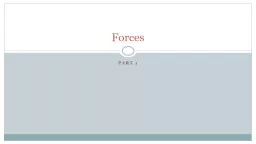

What is a force A force is a push or a pull Forces make objects accelerate What are the two general types of forces How are they different Type 1 Contact Forces Force as a result of object touching ID: 727155
Download Presentation The PPT/PDF document "Part 1 Forces Introduction to Forces" is the property of its rightful owner. Permission is granted to download and print the materials on this web site for personal, non-commercial use only, and to display it on your personal computer provided you do not modify the materials and that you retain all copyright notices contained in the materials. By downloading content from our website, you accept the terms of this agreement.
Slide1
Part 1
ForcesSlide2
Introduction to Forces
What is a force?
A force is a push or a pull.
Forces make objects accelerateWhat are the two general types of forces? How are they different?Type 1: Contact ForcesForce as a result of object touchingTension: Force as a result of an object pulling on a string, cable, or wireType 2: Field ForcesForce as a result of an interaction between objects; objects do not need to touchWeight: Force of gravity (Fg)Acceleration due to gravity = -10 m/s2 = g
Slide3
Drawing a Free-Body Diagram (FBD)
Example 1: A mass hanging by a string
Example 2: A book sitting on a table
F
T
F
g
F
g
F
NSlide4
Forces Acting at Angles
How do you work with forces that are at angles?
Angled forces must be decomposed into components (x and y).
Fx = F cosΘ Fy = F sin ΘExample 3: Mass hanging from two stringsΣFx = T2 cosΘ2 – T1 cosΘ1 = 0ΣFy = T
2
sin
Θ
2
+
T
1
sinΘ1 – mg = 0Slide5
Newton’s First Law of Motion
An object remains at
rest
or in constant motion unless a net force acts on the object.When a = ZERO all forces must BALANCED! Why? Net force results in acceleration.What is inertia and how is it associated with Newton’s First Law?Inertia is the tendency of an object to either remain at rest or in constant motion. Inertia is NOT a force. Slide6
Newton’s Second Law of Motion
Acceleration is
directly
related to net force and indirectly related to mass.In other words, a = ΣF/m OR Fnet = ma
What
is the difference between a force and a NET
force?
A
force is an interaction between 2 objects and net force is the sum of all forces on 1 object.
What is a
normal force
? Why is it called the normal force
?
Normal
force is the perpendicular force applied by a surface.
(normal = perpendicular)
Slide7
Steps to Solving all Force Problems
Draw and label FBD.
Decompose angled forces (determine x and y components).
Sum forces in both directions. ΣFx = right – left ΣFy = up – downΣF = maIf an object is at rest or in constant motion, a = 0 so ΣF = 0Slide8
Example 4:
A 1000 kg car is traveling at 20 m/s. If the engine provides a 2500 N force and wind resistance provides 500 N of force, what is the acceleration of the car? Net force on the car? Distance to get to 30 m/s?
a = 2 m/s
2 ΣF = 2000 N Δx = 125 mSlide9
Lab Review
One Horizontal, One Angled
As the angle increases, both tensions decrease due to the decrease in the x-component force.
Both Angled (Same Angle)The tensions will be equal and as the angle increases the tensions decrease due to the decrease in the x-component force. Both Angled (Different Angles)The larger angled tension will be larger. The x-components must equal so the larger the angle the larger the y-component. Slide10
Static Equilibrium and Tension
Solve for the tension in each of the strings, 1, 2, and 3 and for the angle
Θ
.Slide11
Tension and Newton’s Second Law
Solve for the acceleration of m
1
and for the tension in the string if m1 = 3 kg and m2 = 1 kg. a = 2.5 m/s
2
T = 7.5 NSlide12
Newton’s Third Law
For every action, there is always an equal (
magnitude
) and opposite (direction) reaction.By “action” or “reaction”, it means a force.Action/reaction forces do not act on the same object.Slide13
Action: tire pushes on road
Reaction: road pushes on tire
Slide14
Elevators/Apparent Weight
Apparent weight of an object is a measure of the normal force acting on an object.
Depends on the acceleration of the object
No acceleration (a=0): mg = FN (same weight)Accelerating upward (+a): mg < FN (weigh more)Accelerating downward (-a): mg > FN (weigh less)Free fall (a=g): weightlessSlide15Slide16
Newton’s Law of Universal Gravitation
The
force of gravity between two objects depends
directly on the mass of each object and indirectly on the square of the distance between the objects. Slide17
Effect of Mass and Distance on GravitySlide18
Another way of thinking about g…
Setting
weight
equal to the force of gravity gives:Cancelling the mass gives a more accurate definition of g:Slide19
Reminder
Gravitational
Mass: depends on how an object responds to a
gravitational fieldInertial Mass: depends on how an object accelerates in response to a net force Slide20
Practice 1 and 2